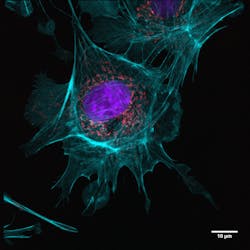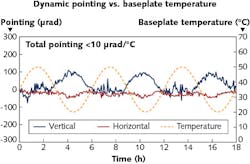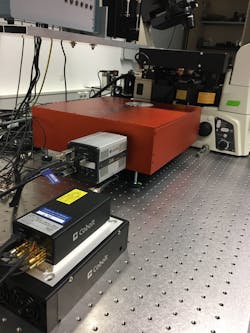Fluorescence Microscopy/Illumination: Highly stable multi-line lasers for next-generation imaging
Scientific advancement relies on an ever-evolving ecosystem. New high-resolution imaging techniques provide extraordinary capabilities to microbiologists, whose applications drive instrumentation developers to explore and identify systems and components that will enable performance and usability improvements.
Fluorescence microscopy in particular has enabled dramatic discoveries, and among the major contributors to the developments of this technique are improvements in data storage (modern high-resolution 3D imaging can generate several tens of terabytes per day from one system), cameras (from low-light-level-sensitive EMCCD technology to the fast readout rates of CMOS, these developments enable measurement of fast processes and minute structures in low-light conditions), and illumination systems.
Offering better efficiency and lifetime, LED-based illumination systems are increasingly replacing traditional lamp-based sources. Supercontinuum sources, now readily available in commercial microscopy systems, offer full freedom to select excitation wavelength.
Single-line lasers remain the only alternative for high-speed, high-resolution multi-species imaging tasks that require high brightness and precise wavelengths. For a decade now, these sources have been evolving from large, bulky gas lasers to compact, solid-state devices with a continuously increasing coverage of wavelengths and power levels. For end users, the progress has meant not only a significant reduction in system footprint, but also longer lifetimes and reduced maintenance requirements. System developers, too, can benefit from these advantages—not only to improve instruments for existing markets, but also to expand their businesses beyond the confines of strictly biomedical research to include drug development and clinical diagnosis.
Robust hardware needed
These latter markets are very demanding and set a high bar for hardware makers. Quantitative/screening applications and clinical diagnostics ideally require systems that are turnkey, intuitive to use, compact, reliable, and virtually service-free. And to enable imaging of many species simultaneously, fluorescence microscopy systems increasingly provide not just one or two laser sources, but often four and even up to eight distinct laser lines. These are typically mounted into a laser combiner, which delivers light into the microscopy setup using one or two optical fiber ports. But achieving stable illumination while combining many individual lasers lines is challenging.
Conventional laser combiner solutions and laser light engines bring individual sources together into a single beam or optical fiber using external optical elements—a strategy that adds bulk and cost to systems. Bulky design makes it difficult to maintain good thermomechanical stability and this fact, combined with relatively long optical distances, means that even small temperature changes can lead to deviations in beam pointing and optical output. Furthermore, if an individual laser source requires service, it is usually necessary to have a service technician from the supplier re-align the system, which boosts cost. All of this adds up to a hurdle for moving advanced bioinstrumentation beyond core research facilities.
Enabling technology
Laser production and packaging advances are addressing this hurdle by enabling extremely compact, permanently aligned, and service-free multi-line devices. The advances allow the integration of all optical elements, including components for beam shaping and alignment, into one temperature-controlled platform. As a result, they eliminate headaches involved in aligning lasers, maintaining that alignment in differing ambient temperature conditions (see Fig. 1), and keeping all the laser lines focused into the 3 μm core of the single-mode/polarization-maintaining (SM/PM) fiber delivery system.By combining both diode-pumped and direct-diode laser technology, any combination of colors from 405 to 660 nm can be integrated, with output powers up to 100 mW. A patent-pending production process enables excellent precision and stability in the beam overlap, resulting in high (up to >80%) as well as stable coupling efficiency when coupling the combined output into SM/PM fibers. All lines can be individually controlled and intensity-modulated using digital input signals up to 5 MHz and analog signals up to 500 kHz. The technology does not require separate digital-to-analog converter boards or signal generators for laser modulation. For lower speed modulation (duty cycles to 1 ms), it is possible to turn individual lines on and off through software. The device maintains alignment in transport conditions, which eliminates the need for alignment of the illumination system in the field.
Beneficiaries
The simplicity that results can benefit both system manufacturers and research labs bursting at the seams with complex equipment. Such a compact (70 × 144 × 38 mm), permanently aligned device also allows researchers to deliver multiple laser lines directly into their experiment, saving valuable laboratory space and being essentially service- and alignment-free. An example of this can been seen in the Department of Biotechnology & Biophysics at Julius-Maximilian-University of Würzburg (Germany), where researchers in the lab of Prof. Dr. Markus Sauer focus on single-molecule sensitive fluorescence spectroscopy and imaging techniques, including super-resolution microscopy and its applications in biomedical sciences. The lab was an early adopter of the new multi-line laser, and has used it, for example, in a single-molecule localization microscopy (SMLM) setup to gain new insights into the organization of proteins within a cell.1 The system provides images with spatial resolution nearing the molecular level, from which quantitative biological data can be extracted (see Fig. 3 and image at the top of this page).Over the past decade, biological research has progressed dramatically. The ability to image dynamic processes of structures and proteins at <150 nm has provided a glimpse into the intricacy of subcellular operations. We've been able to see how embryos develop in 3D and real time and yet, in many ways, we are still only beginning to understand how life is constructed at micro- and nanobiological levels. To reach new frontiers, researchers will rely on novel technologies. As ever, each of the players in the advancement ecosystem will contribute to continuous-improvement cycle that facilitates and enables groundbreaking research.
ACKNOWLEDGEMENTS
HTCure and Skyra are trademarks of Cobolt, a part of HÜBNER Photonics.
REFERENCE
1. M. Sauer and M. Heilemann, Chem. Rev., 117, 7478−7509 (2017); doi:10.1021/acs.chemrev.6b00667.
Elizabeth Illy | Director of Marketing, Cobolt (HÜBNER Photonics)
Elizabeth Illy is director of marketing at Cobolt, a part of HÜBNER Photonics (Solna, Sweden).
Håkan Karlsson | CEO and Cofounder, Cobolt (HÜBNER Photonics)
Håkan Karlsson is CEO and cofounder of Cobolt, a part of HÜBNER Photonics (Solna, Sweden).



